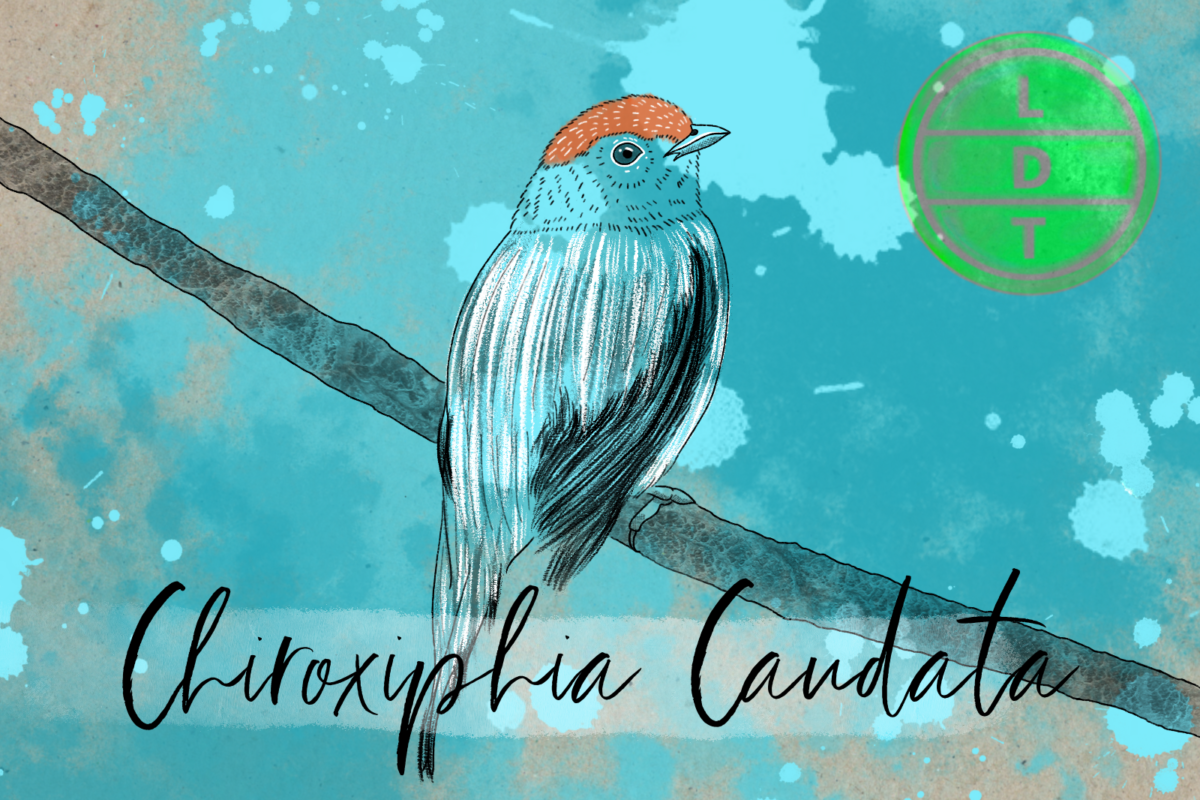“…and today we’re talking about a Casanova with a posse. But more on that later.”
If John Travolta has taught us anything, it’s that the ladies can’t resist a man who can dance. Well, at least that’s true for one species of colorful bird known as the blue manakin. But there are tons of birds out there that dance to get attention, what makes this guy so special? It all comes down to rehearsing with your crew here in Life, Death, and Taxonomy.
Description
- Mannequins are plump, sparrow-shaped birds with round bodies, large heads, and small pointed beaks.
- Blue manakin males are cerulean blue on the body, with black wings and tail feathers.
- They have a black head that’s topped by a red hat.
- Females are dark green with some dark brown or black to blend into the forest.
- Young males start green and develop their blue and red feathers as they age.
Measure Up
Welcome to the beloved Measure Up segment. The official listener’s favorite part of the show! The part of the show when we present the animal’s size and dimension in relatable terms through a quiz that’s fun for the whole family. It’s also the part of the show that’s introduced by you when you send in audio of yourself saying, singing, or chittering the words Measure Up into ldtaxonomy at gmail dot com. We don’t have a measure up intro, so we’ll look back in the archives for our greatest hits.
Length
- 15 cm (5.9 in)
- The James Webb Space Telescope’s first images were released the day we recorded this (a week ago). Among these pictures was the deepest ever photograph since the deep space image taken by the Hubble telescope. The photo depicts an area of the night sky that could be covered by a grain of sand that is held at arm’s length. How many grains of sand go into the length of a blue manakin?
- Hint: The photo is the sharpest infrared photo ever taken and shows red-shifted galaxies that could not be seen on the visible light spectrum. It also shows incredibly distant galaxies that are magnified by a gravitational lens, which is when a massive gravitational force bends and magnifies light that passes through it.
- 146 grains of sand. A grain of sand is a mean of 1.03 mm.
Weight
- 25.6 g (0.90 oz)
- How many blue manakins go into the largest red-footed tortoise ever?
- Hint: The tortoise was found in Paraguay, and it was around 60 cm long.
- 1,120 manikins. The tortoise was 28 kg.
Fast Facts
Blue manakins are found in South America, especially in Argentina, Brazil, and Paraguay. They prefer tropical and subtropical rainforests. They will make a home out of both montane and lowland forests, as long as they’re moist.
Up to five males will live in a 100 square meter area, and one of them will be the alpha.
The feed in the understorey of the forest, which is the layer of vegetation beneath the main canopy. They prefer small fruit and berries, but they will sometimes eat insects.
They often eat fruit in flight, which is a behavior that’s seen in insect-eating birds called hawking. Manakins may have at one time eaten mostly insects until they found out fruit tastes way better.
While males have rigid territorial and social structures, females share large territories and often feed together.
Major Fact: Featherloose
As I mentioned in the intro, it’s not exactly rare to find a brightly-colored tropical bird that dances for the right to make babies. In fact, we’ve covered the manakin bird in a previous episode for its fun moon-walking dance.
But the life of a blue manakin male is possibly the most competitive mating contest in the avian world.
The females are extremely hypergamous – meaning they are highly selective of the males they mate with.
This is so bad, that up to 90% of blue manakin males will never mate.
So this means that the males need to step up 3D in order to stand a chance.
In fact, some males might get just one chance to impress a potential lady friend. So how do you make your dance routine have more impact? Bring a crew.
The blue manakin get 2-6 of its homies together to put on a show she’ll never forget.
This works for everyone. The main man gets a hype crew to help him woo the lady. The backup dancers themselves get a crash course from the prince of persuasia himself.
They are more likely to get some side action for their involvement and they can take the leading role once it opens up.
They have even been shown to rehearse ahead of time! An ornithologist named Newton George observed them practicing between 8 and 2 pm every day.
A young male with juvenile colors will stand in for the female observer.
They can literally spend years practicing and perfecting their dance.
Once it’s showtime, the whole crew will alight on the branch that the female is perched on and start shimmying toward her with the one in front flying around to the back like a red-tuffed conveyor belt.
The lead male will then turn his back and flutter a bunch in the female’s face and then land to await her decision.
Once the position of lead male becomes available the next most dominant male will lead the crew and he’ll already have a team of rehearsed dancers.
Ending: So dress to the nines, get your crew together, and dance the night away for the ladies like the blue manakin here in LDT.

